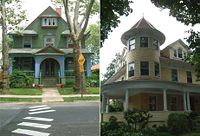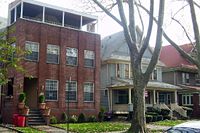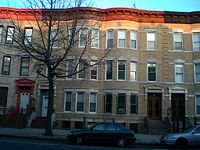Flatbush HousingFrom The Peopling of New York City
Housing Victorian style homes in the Ditmas and South Prospect areas [1] Flatbush has a number of different living quarters. It is not confined to simply apartment buildings. Instead it is the home to houses, apartments, and row houses. A quarter (24.9%) of the housing units in Flatbush are apartment buildings that contain twenty or more units. Almost another quarter (22.8%) of the housing units are made up of one-unit attached living, and two-unit housing makes up another 19.6%. The rest of the population lives in one unit (detached) housing or three to nineteen unit apartment buildings. It is uncommon to find motor homes, trailers, or boats in Flatbush . The median number of rooms in a typical Flatbush living unit is 4.2. Almost half of these structures (44.5%) were built between 1940 and 1959, and more then a quarter (34.6%) were built before 1939. In fact, less then 10 percent (7.2%) of the buildings in this area (Flatbush zip 11203) have been built since the 1970’s. The majority of the people living in Flatbush (as of 2000) had not lived in their current units for more then 20 years. Of these living units, 2.3% lack telephone service, 2% lack complete plumbing facilities, and 1.6% lack complete kitchen facilities. More half of the units lived in by Flatbush residents (54.8%) are worth between $150,000 and $199,000, and the next highest percent (28.4%) are worth between $200,000 and $299,000. Monthly mortgage payments and monthly owner costs are for the most part between $1,000 and $2,000. As of a survey in 1999 33% of monthly owner costs were 35% or more of the resident’s income, the next highest being 11.9% paying between 20 and 24 percent of their income in owner costs. The average amount of rent paid monthly in Flatbush is between $500 and $999. This, much like the monthly owner payments, is 35 percent or more (for 34.4% of the population) and less then 15 to 24 percent for another 40.7% of the population. References
|

